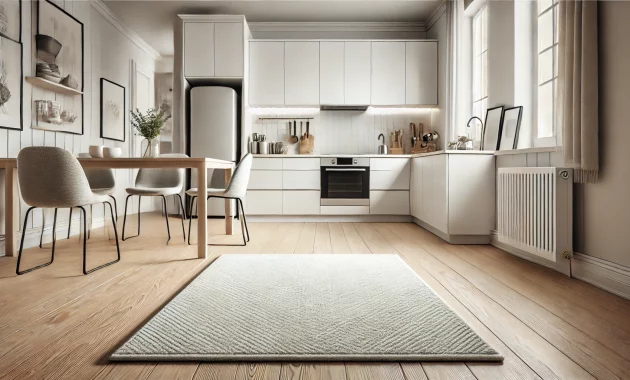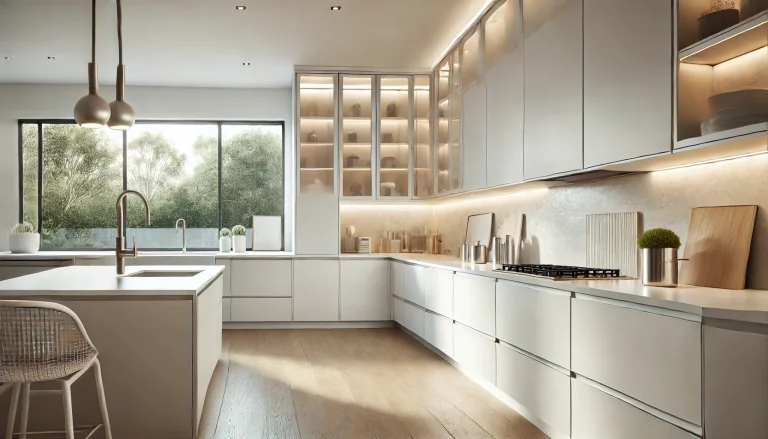How to Choose the Right Kitchen Carpets for Small Spaces
Choosing the right kitchen carpets for a small space can enhance both functionality and style. Opt for low-profile, durable rugs that fit the dimensions of the area while complementing the overall décor. Selecting the right materials also ensures easy maintenance, crucial in a kitchen environment.
When dealing with limited space, consider patterns and colors that can create the illusion of a larger area. Light colors and subtle designs tend to open up the room, while strategically placed carpets can define specific zones, making the kitchen more inviting.
Incorporating textures can also add interest without overwhelming the space. Whether choosing a runner to fit narrow paths or a small area rug under the dining table, thoughtful selections can transform how the kitchen space feels and functions.
Contents
- Assessing Your Kitchen’s Layout and Size
- Defining Your Needs and Preferences
- Selecting the Right Material
- Considering Color and Pattern
- Understanding Size and Shape Options
- Placement Strategies for Small Kitchens
- Maintenance Tips for Longevity
- Navigating Shopping Options
- Making Your Purchase
- Installation Best Practices
Assessing Your Kitchen’s Layout and Size
Understanding the layout and size of the kitchen is crucial in selecting the right carpet. A well-assessed kitchen can enhance both aesthetics and functionality.
Start by measuring the kitchen dimensions. Note the length and width to determine the total area. It’s important to consider these factors:
- Work Zones: Identify areas designated for cooking, cleaning, and food preparation.
- Traffic Flow: Evaluate how people move through the space. The carpet should not obstruct movement.
Next, think about the kitchen’s shape. Is it long and narrow, or more square? This can influence the carpet choice.
Consider the following:
| Layout Type | Recommended Carpet Style |
| Galley | Runner carpets to fit narrow spaces |
| Open Concept | Area rugs to define zones |
| L-Shaped | Smaller area rugs to complement corners |
Factor in storage and appliances too. Ensure the carpet size complements cabinets, countertops, and major appliances. A carpet that fits well will enhance usability.
Remember to consider the textures and colors. Light colors can make a small kitchen appear larger. Darker colors may add warmth but could also make the space feel confined.
Assessing layout and size is the first step toward choosing the ideal kitchen carpet. Make thoughtful choices to maximize both style and practical use.
Defining Your Needs and Preferences
Identifying needs and preferences is crucial when selecting kitchen carpets for small spaces. This process helps narrow down options to the most suitable choices.
Consider the Following Factors:
- Size: Measure the kitchen area to determine the ideal carpet dimensions. A rug that is too large can overwhelm a small space, while a small one may not provide enough coverage.
- Style: Choose a design that complements the kitchen’s aesthetic. This could range from modern patterns to classic looks.
- Material: Opt for durable materials that can withstand spills and stains. Common options include polyester, nylon, and blends that offer easy maintenance.
- Color: Lighter colors can make a small kitchen appear larger, while darker hues can add warmth. It is essential to select a color that balances with the existing decor.
- Functionality: Consider how the carpet will be used. If the kitchen sees heavy foot traffic, look for non-slip options that provide safety.
Personal Preferences:
- Texture: Decide whether a plush or flat-textured carpet is preferred. Textures can influence comfort and foot traffic response.
- Maintenance: Assess how much time is available for cleaning. Low-maintenance carpets may be preferable for busy kitchens.
By clarifying these needs and preferences, individuals can make informed decisions that enhance their small kitchen spaces.
Selecting the Right Material
Choosing the right material for kitchen carpets is essential in maximizing comfort, durability, and ease of maintenance. Each aspect contributes significantly to the functionality of the space, particularly in smaller areas where efficiency is key.
Durability Concerns
Durability is crucial in kitchen environments, as carpets face heavy foot traffic, spills, and stains. Nylon and polyester are popular choices due to their resilience. They can withstand frequent use without showing wear.
While natural fibers like wool provide aesthetic appeal, they may not perform as well in demanding conditions. It is important to consider the carpet’s density and tufting; higher density carpets tend to be more durable.
Moreover, choosing low-pile carpets can reduce the risk of damage, making them easier to maintain and less prone to flattening over time.
Ease of Cleaning
In a kitchen, ease of cleaning often outweighs other factors. Carpets made from synthetic fibers, such as polyester and polypropylene, are typically stain-resistant and can be cleaned with mild detergents.
Selecting a carpet that can handle moisture is important. Water-resistant options help prevent mold and mildew growth.
Consider carpets with stain-repellent treatments, which can provide extra protection against spills. Regular vacuuming, combined with occasional deep cleaning, will help maintain their appearance and hygiene.
Comfort and Texture
Comfort is vital for anyone spending time in the kitchen. Soft, plush carpets can enhance the experience without sacrificing practicality. Look for materials like nylon or wool blends, offering a cozy feel underfoot.
Additionally, texture can impact both aesthetics and comfort. Choosing a carpet with a looped or patterned texture can conceal dirt and stains, contributing to a neat appearance.
To ensure safety, particularly in smaller kitchens where space is limited, opting for carpets with non-slip backing is advisable. This enhances safety while walking in potentially slippery conditions.
Considering Color and Pattern
Selecting the right colors and patterns for kitchen carpets can greatly influence the space’s ambiance. Different colors and designs can either enhance or disrupt the existing décor, making careful consideration essential.
Complementing Your Kitchen’s Color Scheme
When choosing a carpet, it is crucial to consider the kitchen’s existing color palette. A harmonious blend can create a cohesive look. Here are some approaches:
- Neutral Colors: Shades like beige, gray, or soft white can blend well with various styles. They create a calming effect without drawing too much attention.
- Bold Hues: Bright colors such as red or blue can add energy. Ensure they match the kitchen accessories or cabinets to prevent clashing.
- Color Psychology: Warm colors can stimulate appetite, while cool colors tend to promote relaxation. Choose accordingly based on the kitchen’s intended vibe.
Selecting a carpet that complements wall colors, cabinetry, and appliances ensures a balanced aesthetic.
Opting for Patterns or Solids
The choice between patterned and solid carpets can significantly affect the kitchen’s overall appearance. Each option serves a different aesthetic purpose.
- Solid Colors: These offer simplicity and elegance. A solid carpet in a muted tone can act as a backdrop, highlighting other kitchen elements.
- Patterns: Rugs with geometric designs, florals, or stripes can add visual interest. For small kitchens, smaller, intricate designs may be more effective as they create an illusion of space.
- Maintenance Considerations: Patterns may show stains more easily. Solid colors can hide spills better, making them a practical choice for high-traffic areas.
Ultimately, the decision should align with personal taste and the specific kitchen layout.
Understanding Size and Shape Options
Choosing the right size and shape of kitchen carpets is crucial in small spaces. A well-selected carpet can enhance the room’s functionality and aesthetics.
Popular Sizes:
- Runner: Ideal for narrow spaces, ranging from 2 to 3 feet wide and 6 to 10 feet long.
- Medium: Typically 4 to 6 feet square or rectangular, providing comfort without overwhelming the area.
- Area Rugs: These can vary widely, but sizes like 3×5 or 5×7 feet are common, offering flexibility.
Shape Considerations:
- Rectangular: Works well in spaces with defined edges, like hallways or under tables.
- Round: Softens angular spaces and can create a cozy atmosphere, often placed in front of sinks.
- Square: Useful in corner areas or under small dining tables, balancing proportions.
Tips for Measurement:
- Measure the space: Consider the furniture layout and ensure at least 12-24 inches of exposed floor around the edges.
- Think about movement: Choose sizes that allow easy movement, especially in high-traffic areas.
- Layering: In very small kitchens, layering can create depth. Use a smaller rug on top of a larger one for style variety.
Selecting the right size and shape will create a functional and inviting kitchen area without making it feel cramped.
Placement Strategies for Small Kitchens
Maximizing space in a small kitchen requires strategic carpet placement.
- Center the Carpet:
Placing a carpet centrally can help define the kitchen area. This draws attention away from limited space and creates a cozy atmosphere. - Zone Areas:
Use carpets to delineate different functional zones, like cooking, dining, or prep areas. This not only organizes the space but can also enhance visual appeal. - Use Runner Rugs:
Long runner rugs work well in narrow kitchens. They can guide the eye and elongate the space while providing comfort underfoot. - Consider Size and Shape:
Choose carpets that fit within the available space without overwhelming it. Round or oval options can soften sharp corners and add a touch of style. - Avoid High-Pile Carpets:
Opt for low-pile or flat-weave carpets. These options reduce bulk and make it easier to move around in tight spaces while being easier to clean. - Placement Near Key Areas:
Position carpets near sinks or cooking zones for comfort. This can increase safety by providing a non-slip surface where spills or splashes may occur.
Implementing these strategies can make small kitchens feel more functional and inviting.
Maintenance Tips for Longevity
Proper care and upkeep can significantly extend the life of kitchen carpets in small spaces. Regular cleaning and prompt attention to spills will help maintain their appearance and functionality.
Regular Cleaning Practices
Routine cleaning is essential for kitchen carpets to reduce dirt accumulation. Vacuuming at least once a week removes crumbs, dust, and allergens. For best results, use a vacuum cleaner with a brush attachment to lift dirt from the carpet fibers.
In addition to vacuuming, deep cleaning every few months is beneficial. This can involve steam cleaning or using a carpet cleaner with suitable cleaning solutions. Always follow the manufacturer’s instructions regarding cleaning products to avoid damage.
To prevent odors, it is wise to thoroughly dry the carpet after cleaning, as moisture can lead to mold growth. Keeping the kitchen well-ventilated during and after cleaning can aid in this process.
Dealing with Stains and Spills
Acting quickly is crucial when dealing with stains and spills on kitchen carpets. Blot the stain with a clean cloth immediately, absorbing as much liquid as possible without rubbing it in.
For common stains like coffee or grease, a mixture of mild dish soap and warm water can be effective. Apply the solution gently and then blot again; rinse with clean water to remove any soap residue.
For tougher stains, consider a commercially available carpet cleaner designed for the specific type of stain. Always test a small, inconspicuous area first to ensure compatibility. Keeping a stain removal kit nearby can simplify quick responses to accidents.
When selecting kitchen carpets for small spaces, various shopping options exist.
Online Retailers
Shopping online provides convenience and a wider selection. Popular platforms to consider include:
- Amazon
- Wayfair
- Overstock
Local Stores
Visiting local home improvement or specialty stores allows for tactile assessment. Consumers can feel textures and see colors in person. Notable retail options include:
- Home Depot
- Lowe’s
- Bed, Bath & Beyond
Specialty Shops
For unique styles, specialty carpet shops can offer customized options. They may provide expert advice tailored to small spaces.
Considerations
When shopping, focus on:
- Size: Measure kitchen areas for accurate fit.
- Material: Consider durability and ease of cleaning.
- Style: Choose a design that complements existing decor.
Discounts and Sales
Keep an eye out for seasonal sales, clearance events, or promotional discounts. This can lead to significant savings.
Return Policies
Before purchasing, check return policies. This ensures flexibility in case the carpet does not meet expectations after installation.
By evaluating these options, consumers can effectively navigate their selections and find the right kitchen carpets for small spaces.
Making Your Purchase
Choosing the right kitchen carpet for a small space requires careful consideration. Potential buyers should take several factors into account before making a decision.
- Measure Your Space:
Accurate measurements are crucial. This helps in selecting a carpet that fits perfectly without overwhelming the area. - Consider Material:
Different materials offer various benefits. Common options include:
- Polyester: Soft and stain-resistant.
- Nylon: Durable and resilient.
- Cotton: Natural and easy to clean, but less durable.
- Style and Color:
Select a design that complements existing decor. Light colors can make a small space appear larger, while bold patterns can add character. - Texture:
The texture can affect both aesthetics and functionality. Low-pile carpets are easier to clean and maintain, making them ideal for kitchens. - Budget:
Establish a clear budget before shopping. Prices can vary widely, so it’s essential to find a balance between quality and affordability. - Check Reviews:
Reading customer reviews can provide insight into the performance and durability of the carpet. Positive feedback often indicates a well-made product. - Warranty and Return Policy:
Ensure the carpet comes with a warranty. A good return policy is also vital in case the purchase does not meet expectations.
Making an informed decision can lead to a satisfactory purchase, enhancing both the functionality and aesthetic of a small kitchen space.
Installation Best Practices
When installing kitchen carpets in small spaces, proper preparation is essential. This includes cleaning the floor surface thoroughly to remove any dust or debris.
Tools Required:
- Measuring tape
- Carpet cutter or utility knife
- Carpet tape or adhesive
- Straight edge for cutting
Begin by measuring the area to determine the correct carpet size. He or she should leave a little extra material to account for adjustments.
Next, it’s crucial to lay the carpet flat. This prevents wrinkles and ensures an even appearance. If the carpet rolls up, using weights or heavy objects can help.
Adhesive Application:
- Apply carpet tape around the perimeter.
- Use a thin layer of adhesive in the center if needed.
Once the carpet is positioned, press down firmly to secure it in place. This step helps eliminate air bubbles that could cause lifting over time.
Finally, trim excess edges neatly against walls or cabinets. A clean edge makes for a polished look and avoids potential trip hazards.
Following these best practices can lead to a seamless installation, enhancing the kitchen’s appearance and functionality.






